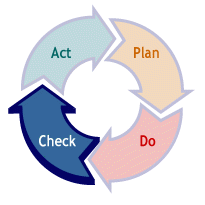ISO14000 -Step 1 - Plan - Environmental Management Systems - explanations, guidance tips and links
By EHSO.com, the site for free, objective, practical information about the environment, health and safety in 2024!
Translate this page to any language by choosing a language in the box below.
ISO14000 -Step 1 - Plan - Environmental Management Systems - explanations, guidance tips and links
 ISO14000 - The
Plan Step
ISO14000 - The
Plan Step
International Standard for
Environmental Management Systems
These pages should help you to understand the International Standards Organization's 14000 standard and decide how to implement it. Click on a topic below to jump to that section. Or start with a Quick explanation of ISO14000.
- "Plan" step
- "Do" step
- "Check" step
- "Act" step
Quick Explanation:
ISO 14001 is a new (late 1996) standard for Environmental Management Systems. It was based upon the ISO 9000 family of specifications, so if you are family with the terms and structure of ISO9001/9002 you will readily grasp ISO14000. The key aspects of ISO14000 are that it is
- voluntary,
- flexible and nonprescriptive,
- Can use existing environmental programs and systems,
- pushes continual improvement,
- encourages cost saving by integrating environmental requirements into the overall company systems (design, manufacturing, etc.) and
- can provide a substantial market advantage.
A primary component of the ISO 14001 standard is the "Environmental Policy" which must be defined by an organization's top management. This environmental policies must include a commitment to both compliance with environmental laws & company policies, continual improvement and prevention of pollution. A system is then created (or if already existing, documented) that ensures that the environmental policy is carried out by the organization. This involves planning, implementation and operations, checking and corrective action, and management review.
The ISO Environmental Standards for Environmental Management Systems (EMS) are a series of completely voluntary standards and guideline reference documents which include environmental management systems, eco-labeling, environmental auditing, life cycle assessment, environmental performance evaluation, and environmental aspects in product standards. It is the focus on management" that distinguishes these standards from "performance" standards. An EMS help and organization to establish and meet its own policy goals through objectives and targets, organizational structures and accountability, management controls and review functions all with top management oversight.
EMS do not set specific requirements for environmental compliance nor do these standards establish requirements for specific levels of pollution prevention or performance.
Guide to Developing an Environmental Management System - Check
Background
Building an Environmental Management System (EMS) might sound like an overwhelming task for a smaller organization, but it need not be. Taken in steps, it is a job that small and medium-sized organizations can tackle. These pages will take you through basic steps as they are outlined in the 2001 Second Edition of Environmental Management Systems: An Implementation Guide for Small and Medium Sized Organizations. The content on this page pulls out particular steps from the "Check" section of the Guide, and points back to specific pages in the guide to fill out worksheets and get additional materials.
Check: Checking, including monitoring and corrective action
As discussed earlier, it is recommended that your EMS be built on the "Plan, Do, Check, Act" model to ensure that environmental matters are systematically identified, controlled, and monitored. Using this approach will help to ensure that performance of your EMS improves over time and that you meet your goals for implementing an EMS in the first place.
This stage continues the step-by-step action plan for developing and implementing the elements of an EMS. By this time, you should have sufficient EMS processes in place to begin to "check" your EMS. One approach is discussed below.

Conduct Internal EMS Audits
Once internal auditors have been selected and trained, you should design and initiate the internal auditing process. At this point, you
should have sufficient EMS processes in place to conduct meaningful audits. Many organizations find that it is easier to start with smaller,
more frequent audits than to audit the entire EMS at once. These early audits can serve as a learning tool. Audit records should be managed
in accordance with the records management process. Once the audit results are known, use the corrective and preventive action process to
address any identified problems.
Ways to save money AND help the environment:
Eat healthier AND save money: Instant Pot Duo Crisp 11-in-1 Air Fryer and Electric Pressure Cooker Combo with Multicooker Lids that Fries, Steams, Slow Cooks, Sautés, Dehydrates
Save water AND money with this showerhead adapter, it lets the water flow until the water is hot, then shuts off water flow until you restart it, ShowerStart TSV Hot Water Standby Adapter
Protect your health with these:
Mattress Dust mite-Bedbug protector, 100% Waterproof, Hypoallergenic, Zippered
Handheld Allergen Vacuum Cleaner with UV Sanitizing and Heating for Allergies and Pet, Kills Mite, Virus, Molds, True HEPA with Powerful Suction removes Hair, Dander, Pollen, Dust,
Immune Support Supplement with Quercetin, Vitamin C, Zinc, Vitamin D3
GermGuardian Air Purifier with UV-C Light and HEPA 13 Filter, Removes 99.97% of Pollutants
5 Stage Air Purifier, Features Ultraviolet Light (UVC), H13 True Hepa, Carbon, PCO, Smart Wifi, Auto Mode, Quiet, Removes 99.97% of Particles, Smoke, Mold, Pet Dander, Dust, Odors
Interesting Reads:
THE PREPPER'S CANNING & PRESERVING BIBLE: [13 in 1] Your Path to Food Self-Sufficiency. Canning, Dehydrating, Fermenting, Pickling & More, Plus The Food Preservation Calendar for a Sustainable Pantry
The Backyard Homestead: Produce all the food you need on just a quarter acre! Paperback
The Citizens' Guide to Geologic Hazards: A Guide to Understanding Geologic Hazards Including Asbestos, Radon, Swelling Soils, Earthquakes, Volcanoes
The Uninhabitable Earth: Life After Warming
Book: The Sixth Extinction: An Unnatural History Paperback